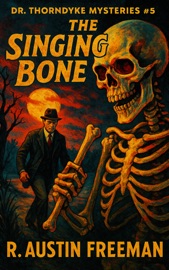The Singing Bone
By R. Austin Freeman

- Release Date: 2025-05-26
- Genre: Mysteries & Thrillers
Description
*The Singing Bone* (1912) by R. Austin Freeman is a landmark collection in the history of detective fiction, notable for pioneering the "inverted detective story" — a genre structure in which the crime and perpetrator are revealed at the beginning, with the narrative focusing instead on how the detective unravels the mystery and proves the criminal’s guilt. This brilliant inversion gives the stories a unique intellectual tension and showcases Freeman’s meticulous approach to forensic science and deductive logic. The book consists of five interlinked short stories featuring Dr. John Thorndyke, a physician and barrister turned scientific detective, whose calm precision and methodical reasoning make him one of the most distinctive sleuths in early 20th-century crime literature. Unlike many detectives of his era, Thorndyke relies not on intuition or dramatic flair but on rigorous scientific method, often using microscopic analysis, chemical tests, and detailed reconstructions of crime scenes to build his cases. In each story, the reader is first shown the crime in detail — who committed it, how it was done, and sometimes even why. The suspense then shifts to Thorndyke’s step-by-step investigation as he pieces together evidence, often using clues so minute they might be dismissed by others. This structure turns the traditional whodunit on its head and instead asks: how will the truth be uncovered? Stories like *The Case of Oscar Brodski* and *The Echo of a Mutiny* showcase Freeman’s skill at combining scientific inquiry with legal logic. *Oscar Brodski*, the first and most famous story in the collection, follows a cunning and remorseless killer who believes he has covered his tracks — only for Thorndyke to quietly dismantle his alibi using medical knowledge and deductive insight. In *A Wastrel’s Romance*, Freeman explores themes of guilt and morality as much as detection, illustrating his depth as a writer concerned not only with crime, but with character and consequence. Freeman’s prose is crisp and clinical, yet not devoid of charm. His descriptions of forensic work are precise without being dry, and his narratives often carry a subtle moral undercurrent. Thorndyke is portrayed not just as a detective but as a man of ethical integrity, representing the triumph of truth through rational thought. The title *The Singing Bone* — taken from a Grimm’s fairy tale about a murder discovered by a bone that sings — metaphorically points to the idea that no crime, no matter how well concealed, is free from traces. The “bone” in each story is the piece of overlooked evidence that ultimately speaks. As an innovator in detective fiction, Freeman influenced later writers such as Dorothy L. Sayers and even modern forensic dramas. *The Singing Bone* remains a compelling read for fans of methodical mystery solving, offering intellectual satisfaction through its clever constructions and scientific flair. It is a testament to the power of observation, the inevitability of truth, and the enduring appeal of the rational mind confronting wrongdoing. In this collection of stories, the reader knows the killer’s identity long before the ingenious medical detective enters the scene. These are brilliant early examples of open mysteries, in which the question is not whodunit—but how will he get caught? This ebook features a new introduction by Otto Penzler and has been professionally proofread to ensure accuracy and readability on all devices.



















































